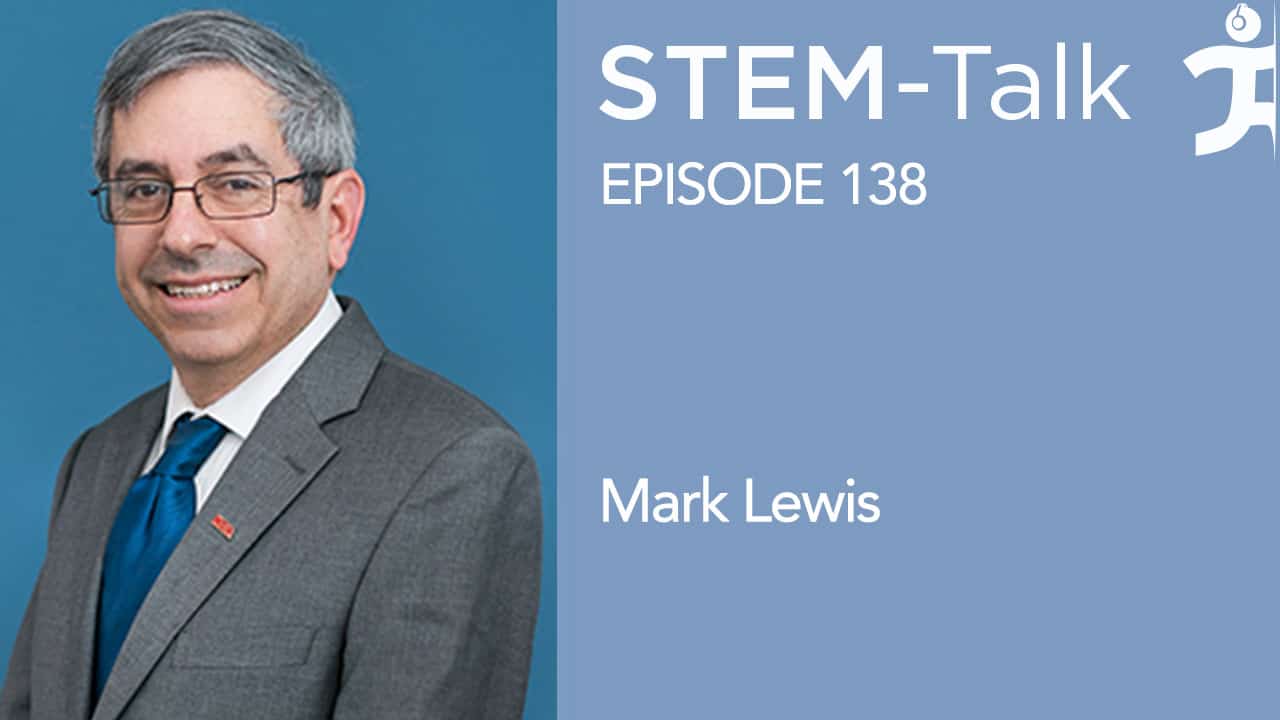STEM-Talk
Episode 138: Mark Lewis discusses hypersonics and the importance of research in national defense
// Jul 6, 2022

Today’s guest is Dr. Mark Lewis, executive director of NDIA’s Emerging Technologies Institute (NDIA ETI), a nonpartisan think tank focused on technologies that are critical to the future of national defense. ETI provides research and analyses to inform the development and integration of emerging technologies into the defense industrial base. We will discuss the Emerging Technologies Institute’s Vital Signs report, which is an evaluation of the readiness and health of the defense industrial base.
Prior to his role at the Emerging Technologies Institute, Mark was the Director of Defense Research & Engineering in the Department of Defense, overseeing technology modernization for all military services and DoD Agencies, as well as the acting Deputy Under Secretary of Defense for Research & Engineering. In this role he was the Pentagon’s senior-most scientist, providing management oversight and leadership for DARPA, the Missile Defense Agency, the Defense Innovation Unit, the Space Development Agency, Federally Funded Research and Development Centers, and the DoD’s basic and applied research portfolio.
At the Department of Defense, Mark worked closely with Mike Griffin, who appeared on episodes 23 and 134 of STEM-Talk. In today’s interview with Mark, we will again discuss hypersonics and other emerging technologies and modernization priorities that are critical to our national defense.
Mark is also the former longest-serving and is perhaps best known for his work in hypersonics.
In addition to these important defense-related roles, Mark is also a professor emeritus at the University of Maryland. He spent 25 years as a faculty member at Maryland, conducting basic and applied research in hypersonic aerodynamics, advanced propulsion, and space-vehicle design.
Show notes:
[00:03:27] Dawn opens the interview asking where Mark grew up and what he was like as a kid. [00:04:29] When Dawn asks Mark when he first became interested in science, Mark tells a funny story form his time as president of the American Institute of Aeronautics and Astronautics? [00:06:21] Ken asks Mark how he ended up at MIT after high school. [00:07:46] Mark talks about taking a job as an assistant professor of aerospace engineering at the University of Maryland after earning his Ph.D. in aeronautics and astronautics at MIT. [00:09:34] Dawn mentions that from 2002 to 2004, Mark was the director of the Space Vehicle Technology Institute. She asks Mark to give an overview of the Institute and the kind of work that goes on there. [00:12:45] Ken mentions that in 2004, Mark became Chief Scientist of the U.S. Air Force, going on to become the longest-serving Chief Scientist in Air Force history. Ken asks Mark to explain the role of the chief scientist, and what he focused on during his time in the position. [00:17:37] Dawn explains that in 2012, Mark became the director of the Science and Technology Policy Institute, which worked with the executive office of the President and other Executive Branch agencies. Mark talks about the kind of work the Science and Technology Policy Institute does. [00:20:23] Dawn mentions that during Mark’s 25 years as a faculty member at the University of Maryland, he conducted basic and applied research in a variety of fields, such as hypersonic aerodynamics, space vehicle design, and advanced propulsion. She point out that Mark, however, is best known for his work in hypersonics. She asks Mark what led him to focus on hypersonics. [00:22:46] Ken asks Mark to explain why he decided to work under Mike Griffin (episodes 23 and 134) in the Pentagon as the Director of Defense Research and Engineering, and what that experience was like. [00:28:19] Dawn mentions that during Mike Griffin’s time as Under Secretary of Defense for Research and Engineering, he made hypersonics the department’s number one priority. Dawn asks Mark to explain the importance of hypersonics in terms of our national defense. [00:33:38] Ken asks Mark when he thinks an air breathing hypersonic tactical round might be available on a production basis. [00:35:40] Ken mentions that Russia recently test-launched the RS-28 Sarmat, a liquid-fueled MIRV-equipped super-heavy intercontinental ballistic missile, sometimes referred to in the west as the “Satan II.” Mark gives his take on the RS-28. [00:39:44] Dawn explains that in 2008, when Mark was concluding his time as Chief Scientist of the Air Force, he launched a study that became known as the Day Without Space Study. This study concluded that we would have a very hard time fighting a war without our relatively vulnerable space assets. Dawn asks Mark to talk about the importance of space in our national defense. [00:43:03] Ken asks Mark about directed energy technology, and its importance in terms of our national defense and weapons capabilities. [00:45:02] Mark discusses his new role as the executive director of the National Defense Industrial Association’s Emerging Technologies Institute, which is a nonpartisan institute focused on technologies that are critical to the future of our national defense. [00:47:28] Dawn asks about the Institute’s ongoing initiative called the Vital Signs Project, which is a report that measures the well-being of the nation’s defense industrial base. [00:48:41] Ken mentions that the 2022 Vital Signs report came out earlier this year with the defense sector receiving an overall poor grade of 69, which is three points below last year’s grade. Ken asks what effect these reports are having. [00:49:50] Dawn explains that in 2022, the authors of the Vital Signs report assigned a failing grade in five areas, with one of the most troubling declines being in supply-chain performance. Dawn goes on to say that the report noted that the decline reflected the turbulence the economy is facing, some of it caused by the COVID-19 pandemic. She also points out that next year’s report is expected to report even greater supply chain issues and she asks Mark to explain why this is such a major problem for the Pentagon. [00:51:57] Ken mentions that another significant drop came in productive capacity and surge readiness. He asks Mark to define what is meant by the term “surge readiness.” [00:54:28] Dawn asks Mark for his take on the fact that U.S. government funding for research and development fell by 12 percent between 2011 and 2016, while in the same time frame China increased its R&D investments by 56 percent. [00:58:54] Ken asks if we are doing a good job of not only researching and developing technologies for our national defense, but also pushing these developments into practical production. [01:02:54] Ken circles back to hypersonics, explaining that the U.S. used to be the world leader in this technology, partly because of our past test-fail approach to innovation. Ken explains that there is a real resistance to that approach to research today in Congress and asks Mark if he believes we need a return to this old mindset for innovation if we are going to catch up with the Chinese and Russians. [01:12:33] Dawn asks what Mark likes to do in his spare time. [01:13:44] Dawn closes the interview and thanks Mark for his time.Links:






